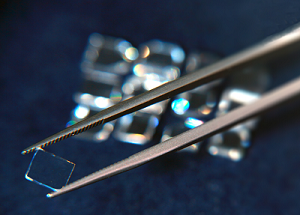IIa Technologies uses a type of Chemical Vapour Deposition (CVD) called Microwave Plasma Chemical Vapour Deposition (MPCVD). This technology, although simpler in form, is much more complicated and expensive than HPHT (High Pressure High Temperature). The technology works at lower pressures exposing multiple diamond seeds to a carbon-rich environment. At the optimised conditions, carbon starts depositing, the seed starts accepting the available carbon, and the natural process of crystallisation starts.
Singapore-based IIa Technologies, a major manufacturer of lab-grown diamonds, said it has created large (7.5 mm x 7.5 mm) high quality, single crystal diamond plates of top quality.
“The breakthrough opens up unprecedented opportunities for use in highly versatile applications such as for radiation dosimeters used in cancer therapy, X-Ray detectors, X-Ray dosimeters, high power electronic devices, etc,” the firm said.
“These high-quality, single crystal diamond plates are expected to break new grounds in radiation detectors due to the simplicity of their design and enhanced lifespan (an increase of about 100-200 times as compared to the conventional material).
IIa Technologies’ believes that when used in applications like particle accelerators, users would benefit from higher uptime and enhanced detection accuracy.
Superior Properties of IIa diamond
Here are the properties of the IIa diamonds.
Other Groups making various diamond crystal
Making diamonds requires patience: a 100-nanometer-thick poly- or nanocrystalline layer can be grown within an hour; single crystals grow at a rate of up to 20 micrometers an hour.
Homogeneously deposition of diamonds with diameters of up to 10 cm on silicon substrates have been produced. However, those are not single crystal.
A high-purity single-crystal diamond made at Fraunhofer IAF. Credit: © Fraunhofer IAF
Fraunhofer IAF experts have mastered the art of producing tiny hollow spheres of synthetic diamond in partnership with Diamond Materials GmbH, a Fraunhofer spin-off based in Freiburg. These little balls could play a central part in future energy production by means of atomic fusion. American scientists are constructing a nuclear fusion reactor in order to tap a source of energy modeled on the sun. The nuclear reaction is triggered when laser beams impact a hollow hydrogen-filled sphere 2 mm in diameter and compresses it to about one ten-thousandth of its original volume. This process fuses the atomic nuclei, releasing enormous amounts of energy. However, for the fusion process to work the balls must be perfectly spherical and have no structural flaws — only then can the huge forces achieve the calculated fusion requirements. “Diamond has the ideal properties for this application,” says Heidrich. But how do they make flat discs into balls? At the core of the solution are tiny silicon globules that are kept constantly in motion in a plasma reactor as they are coated with diamond. It takes about 50 hours for the desired thickness of diamond to build up, at which point the scientists polish the spheres and remove the silicon from inside. To get it out, they drill a tiny hole and then dissolve the silicon out of the ball using a special etching technique based on ultrasound. The hole later serves as the entry point through which they feed the deuterium and tritium fusion charge into the ball.
If you liked this article, please give it a quick review on ycombinator or StumbleUpon. Thanks

Brian Wang is a Futurist Thought Leader and a popular Science blogger with 1 million readers per month. His blog Nextbigfuture.com is ranked #1 Science News Blog. It covers many disruptive technology and trends including Space, Robotics, Artificial Intelligence, Medicine, Anti-aging Biotechnology, and Nanotechnology.
Known for identifying cutting edge technologies, he is currently a Co-Founder of a startup and fundraiser for high potential early-stage companies. He is the Head of Research for Allocations for deep technology investments and an Angel Investor at Space Angels.
A frequent speaker at corporations, he has been a TEDx speaker, a Singularity University speaker and guest at numerous interviews for radio and podcasts. He is open to public speaking and advising engagements.





